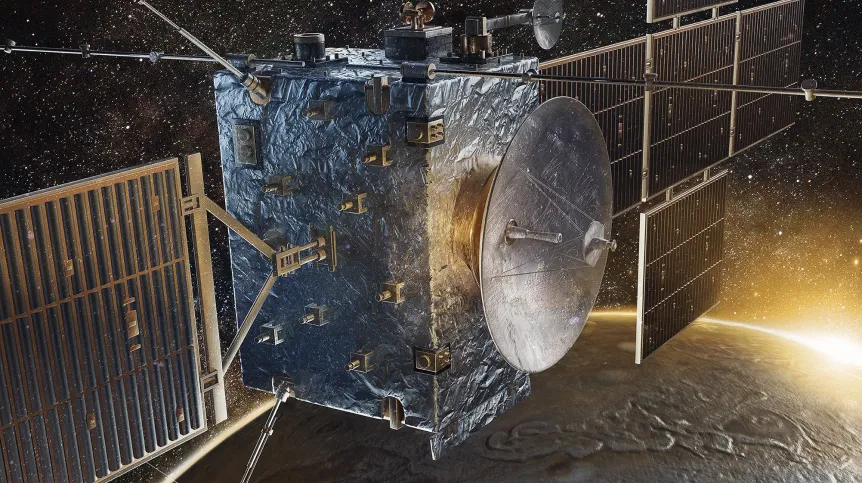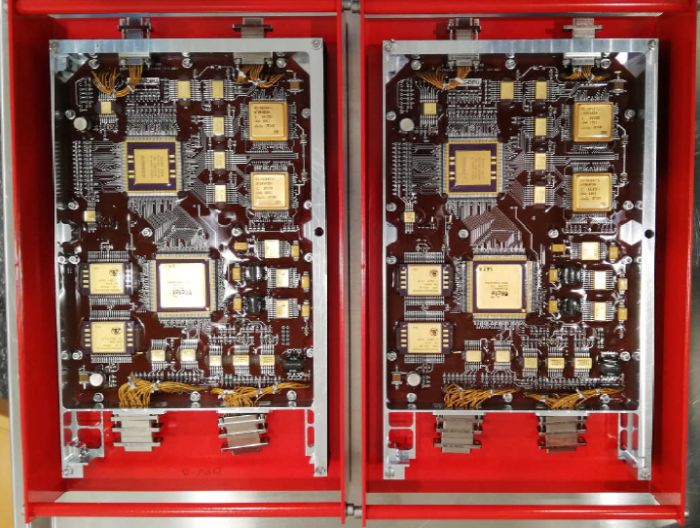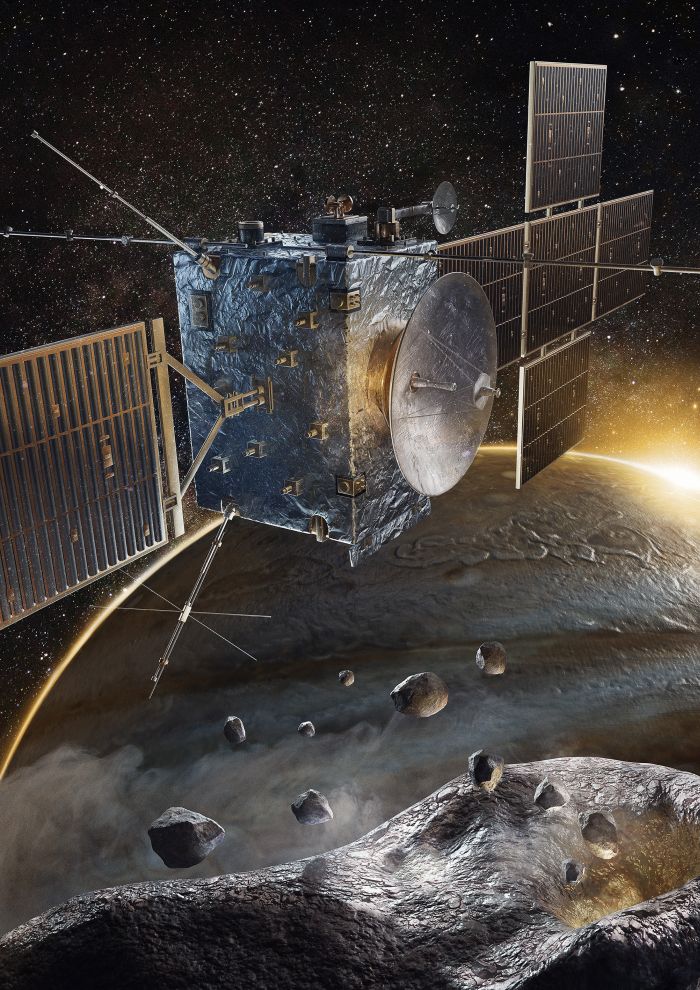
On April 13, one of the European Space Agency's largest missions - Jupiter Icy Moon Explorer (JUICE) is scheduled to launch towards Jupiter. It will try to provide detailed information about the three large moons of Jupiter - Callisto, Europa and Ganymede, and about the entire Jovian system.
Based on this, we will be able to understand how the Solar System and other planetary systems were formed. Professor Hanna Rothkaehl, head of the Plasma Physics Department of the Space Research Centre of the Polish Academy of Sciences, and Konrad Skup from the Laboratory of Satellite Applications of FPGA of the Space Research Centre PAS spoke to PAP about the mission, its goals and the work of Polish specialists.
Professor Hanna Rothkaehl led the Polish group involved in the work on one of the key research instruments of the probe - RPWI (Radio & Plasma Wave Investigation). Konrad Skup is the executive manager of the Polish project that is part of the work on the SWI (Sub-millimeter Wave Instrument).
PAP: Why did the European Space Agency decide to devote its flagship mission to the Jupiter system, and its moons in particular?
Professor Hanna Rothkaehl: This is indeed a groundbreaking mission. The Jovian system resembles a small planetary system. Studying it will therefore provide a lot of information about how planetary systems, including the Solar System, function and form. We will study electromagnetic phenomena, e.g. the magnetic impact of Jupiter's mantle, which protects the entire system from solar radiation. A thorough study of the moons is equally important. They were once thought to be simple, rocky formations with no internal structures. However, it turns out that they have complex structures - they have volcanoes, ice structures, powerful thermal liquid springs, hidden water oceans. The probe will remotely examine these oceans, as well as the atmospheres, ionospheres and magnetospheres of the moons.
Konrad Skup: Jupiter is the largest and, for some, the most beautiful planet in the Solar System. It has wonderful, multi-coloured cloud bands that circle this planet. Fantastic auroras decorate the north and south poles. The red spot, larger than Earth, is a 400-year storm. A powerful magnetic field surrounds the planet, resulting in radiation belts that act as a particle accelerator. It also has 92 moons, of which the four largest and most interesting ones have been known at least since the time of Galileo.
PAP: These moons are of great interest to today's scientists...
K.S.: Among them is Io, on the surface of which, like in Hawaii, there are active volcanoes, from which not lava, not magma, but liquid sulphur flows, and perhaps something more. Europa is a moon covered with a several hundred metres thick layer of ice, perhaps several kilometres thick. There is water under the surface of this ice. Could there be life in this water? Perhaps the geysers that come out of its surface will help us answer this question. Ganymede is the largest moon in the Solar System, larger than the planet Mercury. There are glaciers on its surface, and perhaps rivers, seas or oceans beneath them, like in Greenland. The rest of its surface is rocks. The question is, what are they made of? Finally, Callisto, a very dark moon, but at the same time beautiful. Why is its surface dark? Where did it come from and what does it consist of? Is it carbon or another chemical? And finally, why are all four moons so dramatically different from each other even though they orbit the same planet?
PAP: The probe will have a particularly good look at Ganymede - there are plans to enter its orbit. Why was this particular moon selected?
H.R.: Ganymede is particularly interesting because it probably has a liquid core, it also has its own magnetosphere, ionosphere, atmosphere. Around it, currents form that accelerate particles, including huge amounts of dust. It is also important information that will tell us a lot about how our Solar System functions and we will better understand the physical processes taking place in the Sun and other stars. Ganymede is also the largest moon of the Solar System. The exploration of the Moon is now planned, the next stop will be Mars. However, later bases allowing for the even further space exploration will probably be built on Ganymede.
PAP: Meanwhile, JUICE will have a companion...
H.R.: NASA is preparing the Europa Clipper probe, to be launched towards Jupiter in 2024. The probe will run similar experiments as JUICE. So we will be able to view the complex system of Jupiter from two points. At some point, both probes will be near Europa's orbit. This will significantly increase our research capabilities.
PAP: One of the most important research instruments of the JUICE probe was co-created by your team. What will be its task?
H.R.: The device is called Radio & Plasma Wave Investigation (RPWI). Its task will be to study the electromagnetic field of dust surrounding individual moons. Measuring the gradients of these fields will allow us to look below the surface and analyse the properties of hidden oceans. It will also enable the study of lunar ionospheres, atmospheres and magnetospheres.
PAP: Will the probe's sensors also be capable of detecting possible traces of life?
H.R.: The probe does not have sensors on board that could detect biological traces, but it does have instruments that can detect possible life-related chemicals present, for example, in the atmosphere of a moon. The atmosphere of Ganymede will be examined in extreme detail, because at the end of the mission the probe will crash on this moon. For this reason, it must go through sterilization procedures and tests. The point is to exclude the risk that the target object will be 'infected' with terrestrial life forms.
PAP: What is your contribution to the construction of the probe?
H.R.: Fifteen years ago researchers from Europe who were studying the structure of plasma in the Solar System came to the conclusion that it would be extremely interesting to send a probe to the Jupiter's system. We also took part in promoting this idea. At that time, ESA announced a competition for a new L-type (Large) mission on a large spacecraft. The Americans also had the idea for a similar study of Jupiter and the Laplace program was to be created, which unfortunately failed. Fortunately, ESA continued this cycle of research, and in a three-stage competition, the idea of sending a probe to Jupiter won. Our team, together with colleagues from Sweden, the UK, France, Austria, the Czech Republic and Japan, built the RPWI instrument. I took the position of CoPrincipal Investigator (CoPi), the person managing our team. The Principal Investigator, the expert in charge of the entire RPWI project, was Jan-Erik Wahlund from Uppsala University. Our group built the central computer, some sensors and mechanical parts.
PAP: What did the work involve?
H.R.: First, research goals are set for the entire mission, then a programme to achieve these goals (what we want to measure and how) is developed, taking into account the physical parameters of the environment. For this, the orbit and the amount of necessary fuel are calculated. As for our instrument, first we had to define the goals of the measurements, the manner of conducting them and encoding the data. We built successive models of the instrument and tested them, first on Earth, then on board a satellite. You need to eliminate all interference and have a 100 percent uptime guarantee. If something fails during the mission, there will be no way to fix it, and the probe will fly to Jupiter for over 7.5 years. What's more, it will go through many gravitational assists and, for example, near Venus it can reach a temperature of 300 degrees C, and in another place - minus 200 degrees. That is not all - there is powerful radiation in the Jupiter system, so all on-board systems must be protected against it.
PAP: What was the biggest challenge in this work?
H.R.: The hardest part was probably correlating the operation of all systems and eliminating everything that could interfere with them. The sensors will be so sensitive that they will 'look' under the surface of Ganymede by measuring electric and magnetic fields. This required many years of patient, painstaking tests. We had been working on the entire system for over 10 years. We are thrilled that it worked.
PAP: Another instrument was created at the Space Research Centre in another team. What is its purpose?
H.R.: In cooperation with the German Space Agency, we have built the SWI (Sub-millimeter Wave Instrument) - a radar that will conduct research using millimeter waves.
K.S.: It will tell us what the atmosphere of Jupiter is made of, whether there are organic particles in the geysers of Europa, indicating that there is life under its surface, and we will learn what the glaciers on the surface of Ganymede are made of. The instrument will also shed some light on the surface composition of Jupiter's moons, hopefully revealing what the mysterious dark substance on Callisto's surface is. It will certainly surprise us with several other discoveries.
PAP: What was your contribution to the construction of this device?
K.S.: We were responsible for designing, building and testing three subsystems: the on-board computer for the instrument, the on-board power supply system for the instrument and the radiator, a special plate the size of a knight's shield, placed outside the satellite to radiate the heat generated by the instrument, so that the detectors operate at the lowest possible temperature.
PAP: What was the most difficult part?
K.S.: The project was undoubtedly challenging. On the one hand, SWI is one of the largest instruments on board JUICE, a complex one, in which we were entrusted with the task of implementing equally complex subsystems. We used some of the solutions from our previous projects, such as STIX from the Solar Orbiter mission, or Cassis aboard ExoMars. For others, we had to start from scratch.
PAP: What do you think about the potential of Polish teams when it comes to participation in ESA missions?
K.S.: In some areas we are world leaders and others look at us, but there are also areas in which we still have a lot to learn. We are in no way inferior to our Western colleagues, as evidenced by the fact that in subsequent missions, i.e. ARIEL, Comet Interceptor or IMAP, we are responsible for the entire instruments, not just their subsystems.
PAP: Professor, would you agree?
H.R.: The participation in the JUICE mission opened the way to new programmes for our group. When working with ESA, you need to prove yourself in smaller projects first in order to gain trust and be able to apply for larger programs and greater responsibilities. We already had a certain reputation before - our instruments were sent into space as early as the 1980s, but now the biggest programmes have opened up. I have now been entrusted with the leading role in the construction of one of the instruments (consisting of seven devices placed on two satellites) - the Comet Interceptor. It will be sent to one of the comets that enter the Solar System for the first time. Only groups that already had experience working on other missions could enter this programme.
PAP: Does this mean that Poland is a valuable partner for ESA?
H.R.: We are now entering a level where we are no longer just subcontractors, but start to act as coordinators and main contractors. It is possible that Poles will be even more significant one day - for example, they will be in charge of the entire mission. We have already entered the super league, in which we count. (PAP)
PAP - Science in Poland, Rozmawiał Marek Matacz
mat/ bar/ kap/
tr. RL















